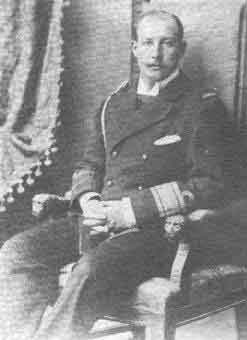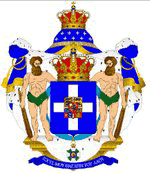|
|

Prince George of Greece and Denmark (24 June 1869 -–25 November 1957) was the third child of King George I of Greece and Grand Duchess Olga. He accompanied Tsar Nicholas II on his trip to Asia as Tsarevich, and saved him from an assassination attempt in Japan. He acted as high commissioner of Crete during its transition towards independence from Ottoman rule and union with Greece. Although much of modern Greece had been independent since the 1820s, Crete remained in Ottoman hands. For the rest of the 19th Century, there had been many rebellions and protests on the island. A Greek force arrived to annex the island in 1897 and the Great Powers acted, occupying the island and dividing into British, French, Russian and Italian areas of control. In 1898, Turkish troops were ejected and a national government was set up, still nominally under Ottoman suzerainty. Prince George, not yet thirty, was made High Commissioner and a joint Muslim-Christian assembly was part-elected, part-appointed. However, this was not enough to satisfy Cretan nationalists. Eleftherios Venizelos was the leader of the movement to reunite Crete with Greece. He had fought in the earlier revolts and was now a member of the Assembly, acting as Minister of Justice to Prince George. They soon found themselves opposed. Prince George, a staunch royalist, had assumed absolute power. Venizelos led the opposition to this. In 1905, however, he summoned an illegal Revolutionary Assembly in Theriso, in the hills near Chania, the then capital of the island. During the revolt, the newly-created Cretan Gendarmerie remained faithful to Prince George. In this difficult period the Cretan population had been divided (in the 1906 elections the pro-Prince parties took 38,127 votes while pro-Venizelos parties took 33,279), but the Gendarmerie managed to execute its duties objectively. Finally, British diplomats brokered a settlement and in September 1906 Prince George was replaced by former Greek prime minister Alexandros Zaimis and left the island. In 1908, the Cretan Assembly declared "enosis" with Greece unilaterally. Prince George was married in 1907 to Princess Marie Bonaparte, daughter of Prince Roland Bonaparte. They had two children - Petros and Evgenia. Peter (1908-1980) was an anthropologist, while their daughter Eugenie (1910-1989) married Prince Dominic Radziwill. Living to the age of 88, Prince George was the longest living of the House of Oldenburg of his generation.
Prince George arrives 9th December 1898 in Souda Georgioupolis, a coastal resort between Chania and Rethimno, was named after Prince George.
Prince George in Crete.
George Stamp from Crete, 1900 (Source: French WP) Prince George, along with his brothers Constantine and Nicolas, was involved with the organization of the 1896 Summer Olympics in Athens. George served as president of the Sub-Committee for Nautical Sports. Retrieved from "http://en.wikipedia.org/"
 |
|
||||||||||||||||





